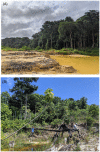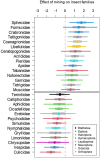Detecting gold mining impacts on insect biodiversity in a tropical mining frontier with SmallSat imagery
- PMID: 35912067
- PMCID: PMC9305433
- DOI: 10.1002/rse2.250
Detecting gold mining impacts on insect biodiversity in a tropical mining frontier with SmallSat imagery
Abstract
Gold mining is a major driver of Amazonian forest loss and degradation. As mining activity encroaches on primary forest in remote and inaccessible areas, satellite imagery provides crucial data for monitoring mining-related deforestation. High-resolution imagery, in particular, has shown promise for detecting artisanal gold mining at the forest frontier. An important next step will be to establish relationships between satellite-derived land cover change and biodiversity impacts of gold mining. In this study, we set out to detect artisanal gold mining using high-resolution imagery and relate mining land cover to insects, a taxonomic group that accounts for the majority of faunal biodiversity in tropical forests. We applied an object-based image analysis (OBIA) to classify mined areas in an Indigenous territory in Guyana, using PlanetScope imagery with ~3.7 m resolution. We complemented our OBIA with field surveys of insect family presence or absence in field plots (n = 105) that captured a wide range of mining disturbances. Our OBIA was able to identify mined objects with high accuracy (>90% balanced accuracy). Field plots with a higher proportion of OBIA-derived mine cover had significantly lower insect family richness. The effects of mine cover on individual insect taxa were highly variable. Insect groups that respond strongly to mining disturbance could potentially serve as bioindicators for monitoring ecosystem health during and after gold mining. With the advent of global partnerships that provide universal access to PlanetScope imagery for tropical forest monitoring, our approach represents a low-cost and rapid way to assess the biodiversity impacts of gold mining in remote landscapes.
Keywords: Artisanal gold mining; Guyana; PlanetScope imagery; biodiversity monitoring; insect bioindicators.
© 2022 The Authors. Remote Sensing in Ecology and Conservation published by John Wiley & Sons Ltd on behalf of Zoological Society of London.
Figures






References
-
- Alpers, C.N. , Yee, J.L. , Ackerman, J.T. , Orlando, J.L. , Slotton, D.G. & Marvin‐DiPasquale, M.C. (2016) Prediction of fish and sediment mercury in streams using landscape variables and historical mining. Science of the Total Environment, 571, 364–379. - PubMed
-
- Alvarez‐Berríos, N. , Campos‐Cerqueira, M. , Hernández‐Serna, A. , Amanda Delgado, C.J. , Román‐Dañobeytia, F. & Aide, T.M. (2016) Impacts of small‐scale gold mining on birds and anurans near the Tambopata Natural Reserve, Peru, assessed using passive acoustic monitoring. Tropical Conservation Science, 9, 832–851.
-
- Barton, P.S. & Evans, M.J. (2017) Insect biodiversity meets ecosystem function: differential effects of habitat and insects on carrion decomposition. Ecological Entomology, 42, 364–374.
LinkOut - more resources
Full Text Sources
Research Materials
